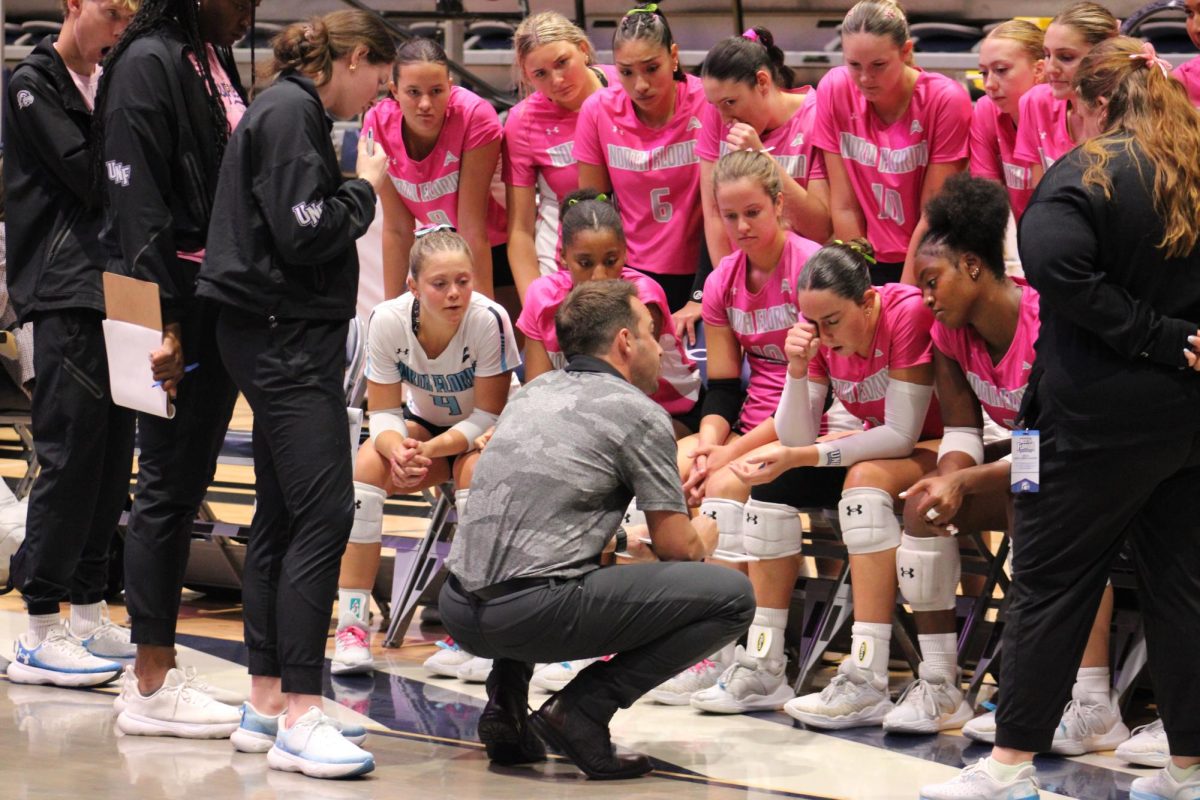 When going to a theater fails, easy-access film viewing prevails
When going to a theater fails, easy-access film viewing prevails
Technological and societal advances in the last half century have replaced the steam engine, the soda pop attendant and the phonograph, and it looks like brick and mortar video rentals stores may be also be going the way of the dodo.
Entertainment seekers now have several options for obtaining their dose of Hollywood. Of course there’s still Blockbuster Video, but then there’s Redbox, Netflix, Hulu and now Blockbuster’s equivalent of Redbox, Blockbuster Express. But which option gains the most popularity among college students?
Currently, there’s a Redbox-like movie kiosk placed in the Osprey Fountains residence hall called an Instaflix carrying all of the new releases much like Redbox does.
“[The residents] seem to really enjoy it, I see them circulate in and out of the Game Room with movie-in-hand,” said Fountains residential assistant and front desk operator Chris Burger. “It looks like it’s being used.”
In the age of on-demand video, movies on your iPod and digital everything, the success of a technology as old as the Coke machine creates quite a tizzy. In just five years, Redbox has grown from a dozen locations to what, by year’s end, it says will be a 20,000-location operation.
“Oh yes we definitely use it,” said Juvaye Lindsey, a UNF nursing sophomore and Fountains resident. “It’s just like a Redbox, but we don’t even have to drive a short distance to pick up the latest titles. I mean, it’s right downstairs.”
Redbox, based in Oakbrook Terrace, Ill., also causes a stir in Hollywood, where movie industry executives are furious over the company’s rent-’em-cheap-when-they’re-new business model.
“Well, it’s just a convenient method for students to rent new release movies on the cheap, and it’s only single buck,” said Zayed Maxam, a UNF international business sophomore and Fountains resident.
The two sides have exchanged harsh words, and Redbox sued three studios in a fight over the company’s effort to circumvent a long-standing distribution hierarchy.
Movies traditionally get released first in theaters, then the DVD version becomes available for sale or rental at full price, typically about $4. Finally, about 30 days later, the videos can be rented or seen online or on pay-per-view starting at about $2.
Redbox has been able to go its own way because its business model, without brick-and-mortar stores, is inexpensive. Everything comes out of its machines for $1, and the company, a unit of Washington state-based Coinstar Inc., says another Redbox machine goes up every hour. Each box contains about 700 DVDs.
For Hollywood, the march of the Redboxes is like a horror flick.
“If movies are devalued in this way, those who work in the movie industry will be directly harmed,” the chief executive of Hastings Entertainment argued in an opinion article published by trade news organization TheWrap. “Reduced industry revenues mean that fewer movies are produced — directly reducing the number of jobs available to people who work both in front of and behind the cameras.”
Mitch Lowe, 56, president of Redbox Automated Retail LLC, said the company stepped in when video stores closed and “the market was trying to push people to buy retail. We figured out an alternative, and we figured out how to develop it at the cheapest cost.”
“We actually tried to reach out to Redbox several times when we were in the developing stages of building Osprey Fountains,” Director of Housing Operations Paul Riel said. “They never got back to us, but it appears that students are using the Instaflix alternative.”
Blockbuster, which closed another 107 stores in the last fiscal year and says it plans to close 810 to 960 more stores through 2010, copies Redbox by rolling out 2,500 kiosks by the end of this year and another 7,000 by the end of 2010, said spokesman Randy Hargrove.
But Blockbuster says it will play by Hollywood’s rules. Blockbuster kiosks rent videos for $1, but the company waits a month or more to stock new releases if studios request it.
But what about Netflix and Hulu? While most college students are aware of what Netflix is and may have even had the service in the past or perhaps back home with their parents, the flat rate of at least $13.99 a month proves to be a little too steep for college students.
Hulu is an Internet staple where students can catch up on the latest episode of NBC’s “The Office” that aired while they sat in class. Primarily more of a “catching up” site, it also offers many documentaries, a smattering of movies and more.
While it’s currently free for users and powered by advertising, viewers can’t exactly watch the latest flicks on demand, and they usually have only the latest five or six episodes of many TV series readily available. But Hulu tries to figure out how to create some kind of premium offering where you’ll pay for stuff that isn’t on the Web site right now.
Whatever form of entertainment college students’ fancy: free-streaming programs online, dollar-menu movies, reasonable monthly movie-club memberships or the occasional splurge on an actual trip to the movie theater, it’s safe to say that the age of $4.99 rentals and back-breaking late fees has ceased.
McClatchy-Tribune Information Services contributed to this article











